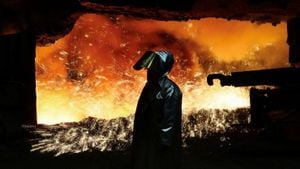Two NASA astronauts have been stranded aboard the International Space Station (ISS) for over three months due to complications with the Boeing Starliner spacecraft.
The Starliner, once seen as the future of American space travel, has faced numerous technical difficulties, including malfunctioning thrusters and issues with its helium tank, preventing their return to Earth.
Engineers on the ground are hard at work troubleshooting the spacecraft's problems using replica test engines. Although they believe they have identified the root cause, significant uncertainty persists, which means additional time is required to implement fixes.
This prolonged stay has led NASA to explore alternative routes to bring the astronauts home. One potential solution is to use SpaceX's Dragon spacecraft, which, if decided upon, could mean the astronauts would remain aboard the ISS until at least February.
Mishaps with the Starliner are not entirely new to Boeing; the craft has seen delays and setbacks since its inception, raising concerns about its reliability.
The astronauts, whose mission duration was initially planned for much shorter, are now adapting to unexpected life on the ISS. They have been focusing on their scientific research and experiments to make the most of their extended stay.
While there is much focus on the astronauts' wellbeing, there are also operational discussions taking place about the future of Starliner missions. These exchanges are aimed at preventing scenarios like this one from reoccurring.
Navigational challenges, caused by malfunctioning thrusters, have led to perplexity among engineering teams, who are striving to understand what went wrong. The uncertainty around the malfunction creates anxiety not only for the astronauts but also for their families and NASA officials.
Material shortages and supply issues are complicate recovery efforts, highlighting the challenges of operating spacecraft built to high standards of precision. The space industry is known for its difficulty and complexity, and the Starliner’s situation adds to the long history of hurdles faced by space missions.
Experts have also raised questions on how this incident might affect NASA's timelines for upcoming missions and potential collaborations with private space companies.
NASA's ISS program is dependent on reliable spacecraft for crew transport. This situation underlines the importance of having multiple options for crew transportation to mitigate single points of failure, particularly as space exploration becomes increasingly ambitious.
Future missions, especially with potential Moon and Mars expeditions on the horizon, are closely being monitored. NASA is aware of the rising need for alternatives and backup plans as they prepare for more extended missions outside lower Earth orbit.
Despite the struggles with the Starliner, the astronauts are still contributing valuable work on the ISS. Their resilience offers important insights as engineers and leaders analyze how to improve spacecraft operations.
Support from families, friends, and the public also plays a significant role during these tough times. Community support helps lift spirits, with many expressing gratitude for the astronauts' dedication and bravery.
The International Space Station remains functional, with daily operations continuing as planned. Inside the ISS, astronauts continue to live and work, using the unique environment of space to advance scientific knowledge.
Calls for transparency have grown as the Starliner situation progresses. Many people following the events want clear communication about astronaut health and the resolution of technical issues.
Space travel is extraordinarily complex, and this situation emphasizes the need for continued investment and innovation. The outcomes of this ordeal will resonate throughout the industry, leading to alterations and improvements.
The eyes of the world remain on Boeing as they work to resolve these challenges efficiently. It's hoped their solutions will prevent similar issues for future missions.
Meanwhile, engineers are tirelessly focused on honing the Starliner's capabilities. The long-term future of the spacecraft is now dependent on fixing these technical failures and restoring its credibility.
NASA continues to engage with Boeing to facilitate effective dialogue and strategic planning. The agency's commitment to the Starliner program will be tested as time reveals the real repercussions of this incident.
Communication lines between ground control and the astronauts remain open, ensuring safety protocols are followed. Updates concerning their situation are shared regularly to keep everyone informed.
Continuous evaluation and support systems are viewed as fundamental as they navigate through the uncertainties. Safety remains the top priority until they can return home.
Consequently, the situation remains fluid, with engineers and mission control exploring all available options to bring the astronauts back safely and efficiently. Meanwhile, the astronauts on board remain optimistic, channeling their energies toward meaningful work on the ISS.
Overall, the Starliner astronauts' saga underlines both the trials of space exploration and the resilience of those who dare to venture beyond Earth. Lessons learned from this heavy testing phase will surely be utilized for future endeavors.



